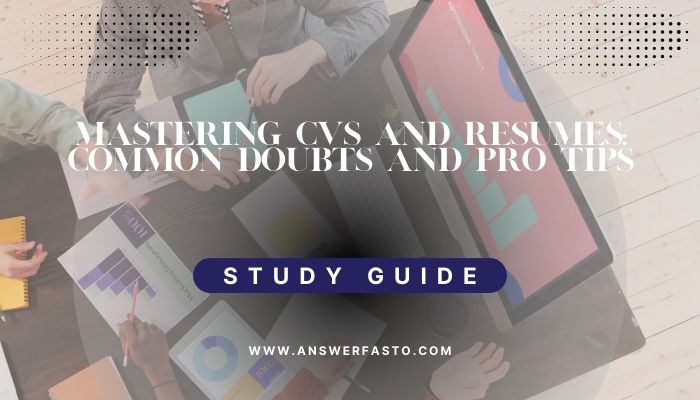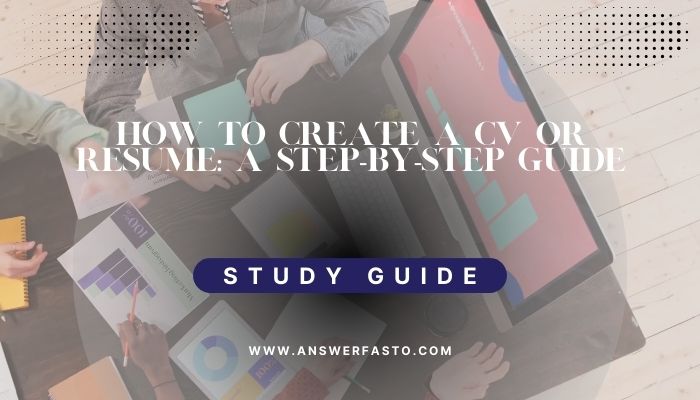Understanding the Basics: Introduction
What is a CV?
A CV, or Curriculum Vitae, is an exhaustive document that showcases your academic evidence, occupational history, knowledge, and certification. It is commonly needed for academic, research, or international job applications.
What is a Resume?
One-page document summarizing your competencies, experience, and qualifications, specifically tailored for one particular job. It is widely used in the corporate and private sectors.
Key Difference:
CVs reflect an overview of your accomplishments, while resumes give a short summary of your accomplishments related to a particular job.
CVs and Resumes: A Few Very Common Questions.
1.Which one is better: a CV or resume?
- CV: directed toward an academic, scientific, or research career.
- Resume: right for corporate worlds such as IT, marketing, or finance.
- But how long should it be?
- Resume: Entry-level career: 1-page. Mid-level to senior career: 2 pages, underlining the relevant experiences.
- CV normally is 2-3 pages; long for academic or research-oriented professions.
- What does work best for the format?
- Reverse Chronological: The latest experience is focused at the top; this is the style for employees who follow a normal career path.
- Functional: Skills only, a regular ability to shift careers. Combination: a balanced approach consists of skills and a chronological work history.
Most Important Sections to Be Included
For Resume:
1.Contact Details
- Your name, professional email address and telephone number, and LinkedIn account are mandatory.
- Professional Summary/Objective
- Summary Statement explaining qualifications and career goals briefly.
- Experience
- Present achievements starting with action verbs – “Driven,” “Managed,” or “Developed.”
- Skills
- Including technical (e.g., Python, SEO) and nontechnical (e.g., leadership, communication) skills.
- Education
- Degree, name of university with graduation year.
- Certification And Training
- All types of certifications and workshops development approved in your profession.
For a CV:
Along with the previous ones for a resume, add the following:
- The material for publication regarding academic positions; List of your published work.
- Research Experiences: Describe major research projects or studies to which you contributed.
- Professional Memberships: Membership in relevant organizations.
Craft a Profile to Create Sensational Curriculum Vitae/Resume
1. Tailor Every Position
- Make every attempt to adjust your skills and accomplishments to the particular area of relevance described in the advertisement other words, return to “making redundancies.”
- Put Down Keywords
- Use words peculiar to the industry so your CV becomes compatible with an application tracking system (ATS).
- Measure Accomplishment
- Measurable examples, such as “increased sales by 25 percent in six months” or “supervised 10 employees,” speak to success.
- Make Visually Attractive
- Select clean and professional fonts like Arial or Calibri.
- Use consistent formatting and appropriate spacing for a polished look.
Mistakes You Should Avoid
1. Do Not Use the Same Resume for Every Application
- Customize Your Resume for the Job to Maximize Your Possibilities
- Mistakes in Grammar
- Proofread your work carefully or apply some apps such as Grammarly to make a definite zero-error document.
- Irrelevant Information Builds an Entry in the Resume
- Mention those aspects which are relevant to the job description.
- Outdated Contact Information
- Double-check all your contact details, including email and phone number, to ensure they are real and current.
Which Document Do You Need?
If you’re facing a dilemma about the two important documents-a CV and a resume-I’ve got you covered! Go through my step-by-step guides:
👉 How to Create a CV or Resume
👉 How to Write a Cover Letter That Stands Out
Start shaping your success today!
Free Templates and Resources
- Find professional CV/Resume templates for free on Overleaf, Google Docs, and even on Canva.



